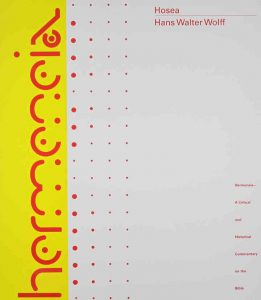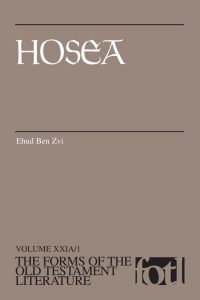Eles instituíram reis sem o meu consentimento,
escolheram príncipes, mas eu não tive conhecimento (Os 8,4a)
No artigo sobre Oseias 4-14 Brad E. Kelle trata das críticas do profeta à monarquia nas p. 335-336:
A primary aspect within this twentieth-century historical study of Hosea 4–14 has been the investigation into the relationship between Hosea and the social, religious, and political institutions of his day, especially the monarchy, priesthood, and prophecy. Debate over the attitude in the book toward the institution of kingship has occupied a prominent place in this regard. Several passages in Hosea explicitly relate to kingship, often talking about the misdeeds and/or removal of the rulers and stressing inappropriate behavior by the king in political, military, and cultic activities (e.g., 5.1-2, 10; 6.11–7.7, 16; 8.4; 9.15; 10.1-4, 7-8a). The referent in most of these texts is the northern monarchy, with only 5.10 dealing with Judah alone within the context of chs. 4–14 (cf. 2.2; 3.4-5). While the references to kingship in 2.2 and 3.4-5 are positive, all of the references in Hosea 4–14 are negative. Among these, the enigmatic condemnation in 8.4 has consistently drawn the most attention, and its meaning continues to confuse (cf. Mays 1969; Wolff 1974; Hayes and Kuan 1991).
The discussion surrounding Hos. 8.4 is representative of the wider range of interpretations of Hosea’s overall view on kingship that appears in commentaries and other studies throughout the modern period. The major question giving rise to divergent interpretations primarily centers on whether Hosea condemns the very existence of the institution of the monarchy, or only engages in a more specific critique. Along these lines, scholars read Hosea’s references to kingship in several major ways, although their conclusions are, at times, partially determined by their views on the book’s redactional history:
1. Hosea opposes the entire system and idea of kingship in principle (Mays 1969; Wolff 1974);
2. Hosea sees the northern monarchy as illegitimate in nature and function (Harper 1905; Rudolph 1966; Emmerson 1984; Macintosh 1997a);
3. Hosea condemns specific kings, especially of the northern kingdom, because of their particular acts of disobedience (Utzschneider 1980; Hayes and Kuan 1991).
(…)
More recently, however, Machinist (2005) offers a complex analysis of the book’s references to the monarchy, and argues that Hosea’s view of kingship is ambiguous. He resists the oversimplifications of many previous analyses, and demonstrates that all of the usual scholarly interpretations can find support within the relevant passages (…) Hosea reflects the deep tension and ambiguity between the problematic nature of the very institution of the monarchy and the reality that kingship will play a role in the future of the restored community.
Um aspecto fundamental da pesquisa sobre Oseias 4–14 no século XX é a investigação da relação do profeta com as instituições sociais, religiosas e políticas de seu tempo, especialmente a monarquia, o sacerdócio e a profecia.
O debate sobre a atitude do profeta em relação à monarquia ocupou um lugar de destaque a este respeito. Várias passagens em Oseias explicitamente se referem à monarquia, muitas vezes falando sobre os erros e/ou remoção* dos governantes e enfatizando o comportamento inadequado do rei nas atividades políticas, militares e cultuais. Os textos tratam, na maioria dos casos, da monarquia de Israel Norte, com apenas Os 5,10 falando de Judá. Embora as referências à monarquia em Os 2,2 e Os 3,4-5 sejam positivas, todas as referências em Oseias 4–14 são negativas. Entre estas, a condenação enigmática em Os 8,4 tem consistentemente atraído mais atenção. E seu significado continua a desafiar os especialistas.
A discussão em torno de Os 8,4 é representativa da gama mais ampla de interpretações, feitas ao longo do século XX, da posição de Oseias a respeito da monarquia. A principal questão que dá origem a interpretações divergentes centra-se principalmente no seguinte dilema: Oseias condena a própria existência da instituição monárquica? Ou apenas faz uma crítica mais específica a uma determinada monarquia ou às decisões políticas reais? Nessa linha, os estudiosos leram as referências de Oseias à monarquia de várias formas. São três as posições principais dos estudiosos:
Oseias à monarquia de várias formas. São três as posições principais dos estudiosos:
1. Oseias se opõe à instituição da monarquia
2. Oseias vê a monarquia de Israel Norte como ilegítima
3. Oseias condena reis específicos, especialmente do reino do norte, por causa de suas decisões equivocadas
(…)
Mas há autores que fazem uma análise mais complexa das referências do livro à monarquia. E argumentam que a visão da monarquia no livro é ambígua. Dizem que é preciso abandonar as supersimplificações de muitas análises e demonstram que todas as interpretações acadêmicas usuais, como as três acima, podem encontrar apoio dentro das passagens relevantes (…) Oseias, na verdade, reflete a profunda tensão e ambiguidade entre a natureza problemática da própria instituição da monarquia e a percepção de que a monarquia desempenhará um papel no futuro da comunidade restaurada. Cf., neste sentido, Machinist, P. 2005.
* Grande instabilidade tomou conta do reino de Israel Norte nos seus últimos 30 anos, pois de 753 a 722 a.C. seis reis se sucederam no trono de Samaria, abalado por assassinatos e golpes sangrentos. Houve 4 golpes de Estado (golpistas: Salum, Menahem, Pecah e Oseias) e 4 assassinatos (assassinados: Zacarias, Salum, Pecahia e Pecah).
